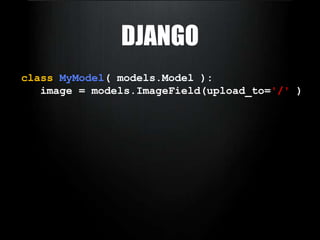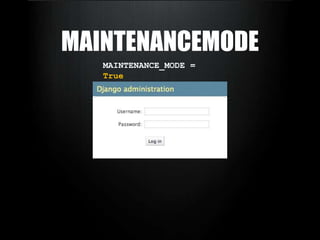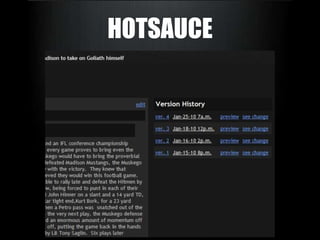Meetup django common_problems(1)
- 2. Who is this fool?!A little about me
- 3. Graphic ArtPhotographyWeb DesignDjangoVFXJavaScriptPrint DesignSoftwareDigital MediaCSSPythonFlash / Flex
- 7. Django = HotPileOfAwesome( yes=True )Django.build_web_app( fast=True )
- 8. Django.make_an_app()>>> TrueDjango.log_in_user()>>> TrueDjango.comment_on_my_model()>>> TrueDjango.message_my_user(user='myuser')>>> TrueDjango.send_emails( emails=['[email protected]'] )>>> TrueDjango.do_complex_SQL( please=True )>>> No Problem!
- 9. Django.make_a_thumbnail()>>> Thumbnail?Django.send_text_message()>>> Email Exception: no such thingDjango.search_all_my_stuff()>>> WTF?Django.get_data_in_under_75_queries()>>> Whoa...Django.alter_table(model='MyModel')>>> Let's not get crazyDjango.be_restful( now=True )>>> you meanrequest.POST
- 10. I've Got an app for that!
- 11. Searching
- 12. SearchingFind Stuff - Fast
- 13. SearchingFind Stuff - Fast( without crushing my DB )
- 15. DjangoMyModel.objects.filter( text__icontains='word' )OR MyModel.objects.filter( text__search='word' )Problems:single model
- 16. slow
- 17. mysql
- 18. manual DB configsHaystackclassPostIndex( SearchIndex ): body = CharField(document = True, model_attr = 'body') title = CharField( model_attr = 'title') author = CharField( model_attr = 'author__get_full_name')text = CharField( use_template = True ) defget_queryset( self ): return Post.objects.all() defprepare_url( self, obj ): return obj.get_absolute_url() site.register(Post, PostIndex)
- 19. HaystackSearchQuerySet().filter( SQ(field=True) | SQ(field__relation="something") ~SQ(field=False) )>>> [ <SearchResult>, <SearchResult>, <SearchResult> ]
- 20. XapianclassArticleIndexer( Indexer ):fields = ['title','body']tags = [('title','title', 3),('body', 'as_plain_text', 1)]space.add_index(Article, ArticleIndexer, attach_as='indexer')
- 21. Xapianfromdjapian.indexer import CompositeIndexerflags = xapian.QueryParser.FLAG_PARTIAL| \xapian.QueryParser.FLAG_WILDCARDindexers = [ Model_1.indexer, Model_2.indexer ]comp = CompositeIndexer( *indexers )s = comp.search( `a phrase` ).flags( flags )>>> [ <hit:score=100>,<hit:score=98> ]$ s[0].instance>>> <ModelInstance:Model>
- 22. HaystackXapianIndex filesClass Based IndexCustomize Text For IndexingLink to Indexed ObjectIndex Fields, Methods & RelationsStemming, Facetting, Highlighting, SpellingPluggable Architecture
- 26. Stored fields
- 28. Templates & Tags
- 29. Views, Forms & Fields
- 32. Doesn't Load All indexers
- 34. Close to the metal ( Control )
- 35. Watches Models for changes
- 37. REST APIExposing Your Data
- 38. REST APIExposing Your Data( In a meaningful way )
- 39. Djangodefview_func( reqeuest, *args, **kwargs): request.GET request.POST request.FILESProblems:PUT & DELETE not translated
- 40. Can't restrict access based on HTTP methods
- 41. Serialization is left up to you
- 42. Manual auth
- 43. Tons of URLsPISTONbitbucket.org/jespern/django-pistonTASTYPIEtoastdriven.github.com/django-tastypie/
- 44. PistonclassMyHandler( BaseHandler ): methods_allowed =( 'GET', 'PUT') model = MyModel classMyOtherHandler( BaseHandler ): methods_allowed =( 'GET', 'PUT') model = MyOtherModelfields = ('title','content',('author',('username',) ) )exclude = ('id', re.compile(r'^private_'))defread( self, request):return [ x for x in MyOtherModel.objects.select_related() ]defupdate( self, request ):...
- 45. TastypieclassMyResource( ModelResource ):fk_field = fields.ForiegnKey( OtherResource, 'fk_field' ) classMeta:authentication = ApiKeyAuthentication() queryset = MyModel.object.all()resource_name = 'resource'fields = ['title', 'content', ]allowed_methods = [ 'get' ]filtering = {'somfield': ('exact', 'startswith')}defdehydrate_FOO( self, bundle ):return bundle.data[ 'FOO' ] = 'What I want'
- 46. Tastypie - Client SidenewRequest.JSONP({url:'http://www.yoursite.com/api/resource',method:'get',data:{username:'billyblanks',api_key:'5eb63bbbe01eeed093cb22bb8f5acdc3',title__startswith:"Hello World"},onSuccess: function( data ){console.info( data.meta );console.log( data.objects ):}).send();http://www.yoursite.com/api/resource/1http://www.yoursite.com/api/resource/set/1;5http://www.yoursite.com/api/resource/?format=xml
- 47. PISTONTASTYPIEMultiple FormatsThrottlingAll HTTP MethodsAuthenticationArbitrary Data ResourcesHighly ConfigurableDjango-like
- 48. Built in fields
- 49. Auto Meta Data
- 50. Resource URIs
- 51. ORM ablities ( client )
- 52. API Key Auth
- 53. Object Caching ( backends )
- 54. De / Re hydrations hooks
- 56. Deep ORM Ties
- 57. Data Streaming
- 58. OAuth / contrib Auth
- 59. URI Templates
- 60. Auto API DocsREADY IN MINUTES
- 61. DATABASE
- 63. SOUTH
- 65. DJANGO$ python manage.py syncdb
- 66. DJANGO$ python manage.py syncdb>>> You have a new Database!
- 67. DJANGOclassMyModel( models.Model):relation = models.ForiegnKey( Model2 )
- 68. DJANGOclassMyModel( models.Model ):relation = models.ForiegnKey( Model2 )classMyModel( models.Model ):relation = models.ManyToMany( Model2 )
- 69. DJANGO$ python manage.py syncdb
- 70. DJANGO$ python manage.py syncdb>>> Sucks to be you!
- 71. WTF?!
- 72. DJANGO$ python manage.py syncdb>>> Sucks to be you!Problem:syncdb doesn't really sync your db. Migrations must be done manually.For everyedatabase / set up.SOUTHMigrations are a set of sequential .py filesdb agnosticHandle most relation typesRolls migrations forward Handles Dependancies / Reverse DependanciesCan convert existing apps Overrides existing syncdb commandDJANGOclassMyModel( models.Model ):relation = models.ForiegnKey( Model2 )classMyModel( models.Model ):relation = models.ManyToMany( Model2 )
- 73. DJANGOclassMyModel( models.Model ):relation = models.ForiegnKey( Model2 )classMyModel( models.Model ):relation = models.ManyToMany( Model2 )
- 74. SOUTH$ python manage.py schemamigration <yourapp>>>> Sweet, run migrate
- 75. SOUTH$ python manage.py migrate <yourapp>>>> Done.
- 76. SOUTH
- 78. QUERYSET-TRANSFORM{%for object in object_list %}{%for object in object.things.all %}{%if object.relation %}{{ object.relation.field.text }}{%else%}{{ object.other_relation }}{%endif%}{%endfor%}{%empty%}no soup for you{%endfor%}
- 80. QUERYSET-TRANSFORMdeflookup_tags(item_qs):item_pks = [item.pk for item in item_qs]m2mfield = Item._meta.get_field_by_name('tags')[0]tags_for_item = \Tag.objects.filter(item__in = item_pks).extra(select = {'item_id': '%s.%s' % (m2mfield.m2m_db_table(),m2mfield.m2m_column_name()) }) tag_dict = {}for tag in tags_for_item:tag_dict.setdefault(tag.item_id, []).append(tag)for item in item_qs:item.fetched_tags = tag_dict.get(item.pk, [])
- 81. QUERYSET-TRANSFORMqs = Item.objects.filter(name__contains = 'e').transform(lookup_tags)
- 82. QUERYSET-TRANSFORMfrom django.db import connectionlen( connection.queries )>>> 2
- 84. DJANGO-SELECTREVERSETries prefetching on reverse relationsmodel_instance.other_model_set.all()
- 87. WEBCUBE-CMS
- 89. WEBCUBE-CMSFeature CompleteRobust & Flexible
- 90. WEBCUBE-CMSFeature CompleteRobust & Flexible( Commercial License )
- 91. $12,000
- 92. $12,000
- 94. + $300 / mo
- 95. WTF?!
- 96. DJANGO-CMS
- 99. Plugin Support
- 100. Template Switching
- 101. Menu Control
- 102. Translations
- 103. Front-End Editing ( latest )
- 104. Moderation
- 105. Template Tags
- 106. Lots of settings
- 107. Lots Of Settings ( again )
- 109. Plone Paradox
- 110. Plugins a little wonkySATCHMO
- 112. Django Admin
- 114. GRAPPELLI
- 115. GRAPPELLI
- 116. GRAPPELLI
- 117. FILEBROWSER
- 118. FILEBROWSER
- 119. FILEBROWSER
- 120. FILEBROWSER
- 121. ADMIN TOOLS
- 122. ADMIN TOOLS
- 123. ADMIN TOOLS
- 124. Image Management
- 126. DJANGOclassMyModel( models.Model ):image = models.ImageField(upload_to='/' )
- 127. DJANGOclassMyModel( models.Model ):image = models.ImageField( upload_to='/' )thumb = models.ImageField( upload_to='/' )
- 128. DJANGOclassMyModel( models.Model ):image = models.ImageField( upload_to='/' )thumb = models.ImageField( upload_to='/' )>>> MyModel.objects.get(pk=1)>>> MyModel.objects.image.url>>> MyModel.objects.thumb.url
- 129. ImageField
- 132. IMAGEKITclassPhoto( ImageModel ):name = models.CharField(max_length=100)image = models.ImageField(upload_to='photos') views = models.PositiveIntegerField(default=0)classIKOptions:#define the ImageKit optionsspec_module = 'myapp.specs'cache_dir = 'photos'image_field = 'image'save_count_as = 'views'
- 133. IMAGEKITclassResizeThumb( processors.Resize ):width = 100height = 75crop = TrueclassResizeDisplay( processors.Resize ):width = 600# now we can define our thumbnail specclassThumbnail( ImageSpec ):access_as = 'thumbnail_image'pre_cache = Trueprocessors = [ ResizeThumb ]classDisplay( ImageSpec ):increment_count = Trueprocessors = [ ResizeDisplay ]
- 134. IMAGEKIT$ photo = Photo.objects.get( pk =1 )$ photo.display.url>>> u'/path/to/media/photo_display.jpg'$ photo.thumbnail.width>>> 100
- 135. IMAGEKITPHOTLOGUECachingTemplate FriendlyHighly ConfigurableManagement CommandsOnly 1 Model
- 136. DB Friendly
- 137. Format Adjustment
- 138. Color Adjustment
- 139. Transposing
- 140. Galleries out of the box
- 141. Bulk Upload
- 142. Admin Integration
- 143. Pre-cache command
- 144. Very DB Dependant
- 145. 4 Models ( 2 Solid )
- 146. Templates / Views / Urls
- 147. Exif SupportEXIF TAGSISSUE 153( shameless plug )
- 148. IMAGEKITPHOTLOGUECachingTemplate FriendlyHighly ConfigurableManagement CommandsOnly 1 Model
- 149. DB Friendly
- 150. Format Adjustment
- 151. Color Adjustment
- 152. Transposing
- 153. Galleries out of the box
- 154. Bulk Upload
- 155. Admin Integration
- 156. Pre-cache command
- 157. Very DB Dependant
- 158. 4 Models ( 2 Solid )
- 159. Exif SupportBeware of View Counts
- 160. ImageField
- 162. SORL
- 163. SORLfrom sorl.thumbnail import ImageFieldclassMyModel( models.Model ):iamge = ImageField( upload_to="/folder" )
- 164. SORL{% load thumbnail %}{%thumbnail obj.image "1000x600" crop='top' as im %}<img src="{{ im.url }}" />{%endthumbnail%}
- 165. MESSAGING
- 166. User - to - UserMessaging
- 168. DJANGO-SMS
- 169. DJANGO-SMSUser Enters Phone #User Selects Carrier
- 170. THATS IT
- 171. FREE
- 172. UTILS
- 174. DJANGO-EXTENSIONS21 Commands4 Fields2 Models1 Admin Extension ( FK AutoComplete )$ python manage.py dumpscript>>> your_app.py$ python manage.py runscript>>> your_app.pyc$ python manage.py runserver_plus>>> Debugger baked right in$ python manage.py shell_plus>>> AutoLoad Models$ python manage.py show_urls>>> /your/endpoint/:idproject.app.views.view_func
- 175. RUNSERVER_PLUS
- 176. DEBUG TOOLBAR
- 177. DEBUG TOOLBAR
- 178. MAINTENANCEMODE
- 182. HOTSAUCE
- 183. HOTSAUCEI Put That $*!T On Everything
- 184. HOTSAUCE
- 185. HOTSAUCE
- 187. HOTSAUCE








![Django.make_an_app()>>> TrueDjango.log_in_user()>>> TrueDjango.comment_on_my_model()>>> TrueDjango.message_my_user(user='myuser')>>> TrueDjango.send_emails( emails=['me@mail.com'] )>>> TrueDjango.do_complex_SQL( please=True )>>> No Problem!](https://image.slidesharecdn.com/meetupdjangocommonproblems1-110511222159-phpapp02/85/Meetup-django-common_problems-1-8-320.jpg)



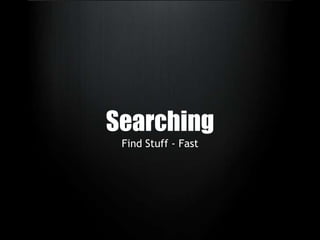


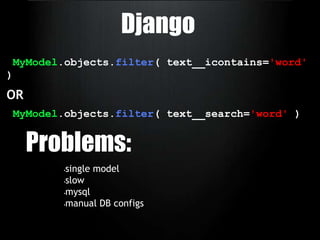



![HaystackSearchQuerySet().filter( SQ(field=True) | SQ(field__relation="something") ~SQ(field=False) )>>> [ <SearchResult>, <SearchResult>, <SearchResult> ]](https://image.slidesharecdn.com/meetupdjangocommonproblems1-110511222159-phpapp02/85/Meetup-django-common_problems-1-19-320.jpg)
![XapianclassArticleIndexer( Indexer ):fields = ['title','body']tags = [('title','title', 3),('body', 'as_plain_text', 1)]space.add_index(Article, ArticleIndexer, attach_as='indexer')](https://image.slidesharecdn.com/meetupdjangocommonproblems1-110511222159-phpapp02/85/Meetup-django-common_problems-1-20-320.jpg)
![Xapianfromdjapian.indexer import CompositeIndexerflags = xapian.QueryParser.FLAG_PARTIAL| \xapian.QueryParser.FLAG_WILDCARDindexers = [ Model_1.indexer, Model_2.indexer ]comp = CompositeIndexer( *indexers )s = comp.search( `a phrase` ).flags( flags )>>> [ <hit:score=100>,<hit:score=98> ]$ s[0].instance>>> <ModelInstance:Model>](https://image.slidesharecdn.com/meetupdjangocommonproblems1-110511222159-phpapp02/85/Meetup-django-common_problems-1-21-320.jpg)





















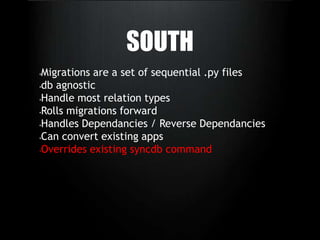
![PistonclassMyHandler( BaseHandler ): methods_allowed =( 'GET', 'PUT') model = MyModel classMyOtherHandler( BaseHandler ): methods_allowed =( 'GET', 'PUT') model = MyOtherModelfields = ('title','content',('author',('username',) ) )exclude = ('id', re.compile(r'^private_'))defread( self, request):return [ x for x in MyOtherModel.objects.select_related() ]defupdate( self, request ):...](https://image.slidesharecdn.com/meetupdjangocommonproblems1-110511222159-phpapp02/85/Meetup-django-common_problems-1-44-320.jpg)
![TastypieclassMyResource( ModelResource ):fk_field = fields.ForiegnKey( OtherResource, 'fk_field' ) classMeta:authentication = ApiKeyAuthentication() queryset = MyModel.object.all()resource_name = 'resource'fields = ['title', 'content', ]allowed_methods = [ 'get' ]filtering = {'somfield': ('exact', 'startswith')}defdehydrate_FOO( self, bundle ):return bundle.data[ 'FOO' ] = 'What I want'](https://image.slidesharecdn.com/meetupdjangocommonproblems1-110511222159-phpapp02/85/Meetup-django-common_problems-1-45-320.jpg)










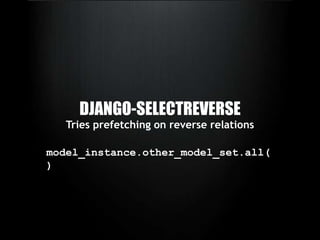























![QUERYSET-TRANSFORMdeflookup_tags(item_qs):item_pks = [item.pk for item in item_qs]m2mfield = Item._meta.get_field_by_name('tags')[0]tags_for_item = \Tag.objects.filter(item__in = item_pks).extra(select = {'item_id': '%s.%s' % (m2mfield.m2m_db_table(),m2mfield.m2m_column_name()) }) tag_dict = {}for tag in tags_for_item:tag_dict.setdefault(tag.item_id, []).append(tag)for item in item_qs:item.fetched_tags = tag_dict.get(item.pk, [])](https://image.slidesharecdn.com/meetupdjangocommonproblems1-110511222159-phpapp02/85/Meetup-django-common_problems-1-80-320.jpg)






